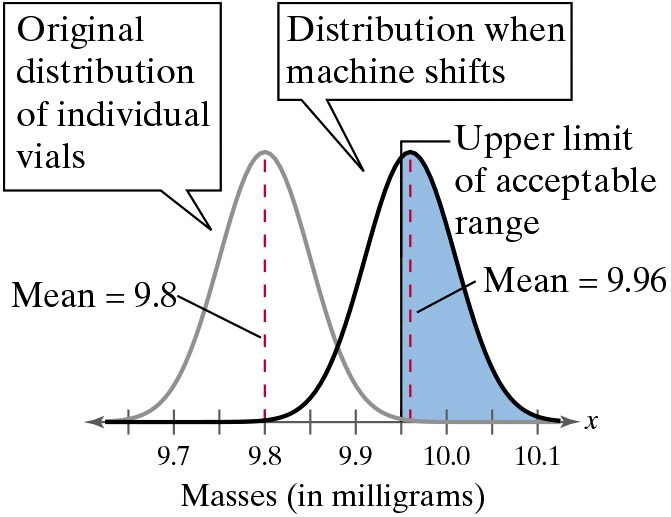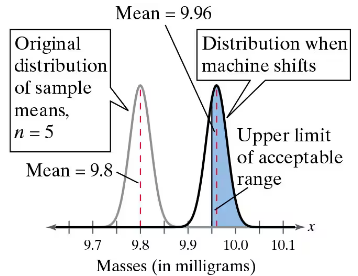 Back
BackProblem 5.R.35
Determine whether any of the events in Exercise 33 are unusual. Explain your reasoning.
Problem 5.R.38
In Exercises 37–42, use the Standard Normal Table or technology to find the z-score that corresponds to the cumulative area or percentile.
0.1
Problem 5.R.41
In Exercises 37–42, use the Standard Normal Table or technology to find the z-score that corresponds to the cumulative area or percentile.
P85
Problem 5.R.61
In Exercises 61 and 62, a binomial experiment is given. Determine whether you can use a normal distribution to approximate the binomial distribution. If you can, find the mean and standard deviation. If you cannot, explain why.
A survey of U.S. adults ages 33 to 40 earning more than $150,000 per year found that 94% are content with how their lives have turned out so far. You randomly select 20 U.S. adults ages 33 to 40 earning more than $150,000 and ask if they are content with their lives so far.
Problem 5.R.64
In Exercises 63–68, write the binomial probability in words. Then, use a continuity correction to convert the binomial probability to a normal distribution probability.
P(x ≤ 36)
Problem 5.R.67
In Exercises 63–68, write the binomial probability in words. Then, use a continuity correction to convert the binomial probability to a normal distribution probability.
P(x < 60)
Problem 5.Q.5
In a standardized IQ test, scores are normally distributed, with a mean score of 100 and a standardized deviation of 15. Use this information in Exercises 3–10. (Adapted from 123test)
What percent of the IQ scores are greater than 112?
Problem 5.Q.11
In a survey of U.S. adults, 81% feel they have little or no control over data collected about them by companies. You randomly select 250 U.S. adults and ask them whether they feel they have control over data collected about them by companies. Use this information in Exercises 11 and 12. (Source: Pew Research Center)
Determine whether you can use a normal distribution to approximate the binomial distribution. If you can, find the mean and standard deviation. If you cannot, explain why.
Problem 5.RS.1a
Assume the machine shifts and the distribution of the amount of the compound added now has a mean of 9.96 milligrams and a standard deviation of 0.05 milligram. You select one vial and determine how much of the compound was added.
a. What is the probability that you select a vial that is within the acceptable range (in other words, you do not detect that the machine has shifted)? (See figure.)
Problem 5.CR.1c
A survey of adults in the United States found that 61% ate at a restaurant at least once in the past week. You randomly select 30 adults and ask them whether they ate at a restaurant at least once in the past week. (Source: Gallup)
c. Is it unusual for exactly 14 out of 30 adults to have eaten in a restaurant at least once in the past week? Explain your reasoning.
Problem 5.R.51b
In Exercises 51 and 52, a population and sample size are given. (b) List all samples (with replacement) of the given size from the population and find the mean of each. (c) Find the mean and standard deviation of the sampling distribution of sample means and compare them with the mean and standard deviation of the population.
The goals scored in a season by the four starting defenders on a soccer team are 1, 2, 0, and 3. Use a sample size of 2.
Problem 5.R.53
In Exercises 53 and 54, find the mean and standard deviation of the indicated sampling distribution of sample means. Then sketch a graph of the sampling distribution.
The population densities in people per square mile in the 50 U.S. states have a mean of 199.6 and a standard deviation of 265.4. Random samples of size 35 are drawn from this population, and the mean of each sample is determined.
Problem 5.R.54
In Exercises 53 and 54, find the mean and standard deviation of the indicated sampling distribution of sample means. Then sketch a graph of the sampling distribution.
The test scores for the Law School Admission Test (LSAT) in a recent year are normally distributed, with a mean of 151.88 and a standard deviation of 9.95. Random samples of size 40 are drawn from this population, and the mean of each sample is determined.
Problem 5.Q.4a
The random variable x is normally distributed with the given parameters. Find each probability.
a. μ = 9.2, σ ≈ 1.62, P(x < 5.97)
Problem 5.Q.4b
The random variable x is normally distributed with the given parameters. Find each probability.
b. μ = 87, σ ≈ 19, P(x > 40.5)
Problem 5.Q.4c
The random variable x is normally distributed with the given parameters. Find each probability.
c. μ = 5.5, σ ≈ 0.08, P(5.36 < x < 5.64)
Problem 5.Q.4d
The random variable x is normally distributed with the given parameters. Find each probability.
d. μ = 18.5, σ ≈ 4.25, P(19.6 < x < 26.1)
Problem 5.R.69a
In Exercises 69 and 70, determine whether you can use a normal distribution to approximate the binomial distribution. If you can, use the normal distribution to approximate the indicated probabilities and sketch their graphs. If you cannot, explain why and use a binomial distribution to find the indicated probabilities.
A survey of U.S. adults found that 72% used a mobile device to manage their bank account at least once in the previous month. You randomly select 70 U.S. adults and ask whether they used a mobile device to manage their bank account at least once in the previous month. Find the probability that the number who have done so is (a) at most 40.
Problem 5.R.69b
In Exercises 69 and 70, determine whether you can use a normal distribution to approximate the binomial distribution. If you can, use the normal distribution to approximate the indicated probabilities and sketch their graphs. If you cannot, explain why and use a binomial distribution to find the indicated probabilities.
A survey of U.S. adults found that 72% used a mobile device to manage their bank account at least once in the previous month. You randomly select 70 U.S. adults and ask whether they used a mobile device to manage their bank account at least once in the previous month. Find the probability that the number who have done so is (b) exactly 50.
Problem 5.R.69c
In Exercises 69 and 70, determine whether you can use a normal distribution to approximate the binomial distribution. If you can, use the normal distribution to approximate the indicated probabilities and sketch their graphs. If you cannot, explain why and use a binomial distribution to find the indicated probabilities.
A survey of U.S. adults found that 72% used a mobile device to manage their bank account at least once in the previous month. You randomly select 70 U.S. adults and ask whether they used a mobile device to manage their bank account at least once in the previous month. Find the probability that the number who have done so is (c) greater than 60.
Problem 5.RS.1b
Assume the machine shifts and the distribution of the amount of the compound added now has a mean of 9.96 milligrams and a standard deviation of 0.05 milligram. You select one vial and determine how much of the compound was added.
b. You randomly select 15 vials. What is the probability that you select at least one vial that is within the acceptable range?
Problem 5.RS.2a
Assume the machine shifts and is filling the vials with a mean amount of 9.96 milligrams and a standard deviation of 0.05 milligram. You select five vials and find the mean amount of compound added.
a. What is the probability that you select a sample of five vials that has a mean that is within the acceptable range? (See figure.)
Problem 5.R.55a
In Exercises 55–60, find the indicated probabilities and interpret the results.
Refer to Exercise 33. A random sample of 2 years is selected. Find the probability that the mean amount of greenhouse gases for the sample is (a) less than 5500 MMT CO2 eq. Compare your answers with those in Exercise 33.
Problem 5.R.56a
In Exercises 55–60, find the indicated probabilities and interpret the results.
Refer to Exercise 34. A random sample of six days is selected. Find the probability that the mean surface concentration of carbonyl sulfide for the sample is (a) between 5.1 and 15.7 picomoles per liter. Compare your answers with those in Exercise 34.
Problem 5.R.57a
In Exercises 55–60, find the indicated probabilities and interpret the results.
The mean ACT composite score in a recent year is 20.7. A random sample of 36 ACT composite scores is selected. What is the probability that the mean score for the sample is (a) less than 22, (b) greater than 23, and (c) between 20 and 21.5? Assume sigma=5.9.
Problem 5.R.58a
In Exercises 55–60, find the indicated probabilities and interpret the results.
The mean MCAT total score in a recent year is 500.9. A random sample of 32 MCAT total scores is selected. What is the probability that the mean score for the sample is (a) less than 503? Assume sigma=10.6.
Problem 5.R.59a
In Exercises 55–60, find the indicated probabilities and interpret the results.
The mean annual salary for Level 1 actuaries in the United States is about $72,000. A random sample of 45 Level 1 actuaries is selected. What is the probability that the mean annual salary of the sample is (a) less than $75,000? Assume sigma = $11,000.
Problem 5.R.60a
In Exercises 55–60, find the indicated probabilities and interpret the results.
The mean annual salary for physical therapists in the United States is about $87,000. A random sample of 50 physical therapists is selected. What is the probability that the mean annual salary of the sample is (a) less than $84,000? Assume sigma = $10,500.
Problem 5.R.55b
In Exercises 55–60, find the indicated probabilities and interpret the results.
Refer to Exercise 33. A random sample of 2 years is selected. Find the probability that the mean amount of greenhouse gases for the sample is (b) between 6000 and 6500 MMT CO2 eq. Compare your answers with those in Exercise 33.
Problem 5.R.55c
In Exercises 55–60, find the indicated probabilities and interpret the results.
Refer to Exercise 33. A random sample of 2 years is selected. Find the probability that the mean amount of greenhouse gases for the sample is (c) greater than 5900 MMT CO2 eq. Compare your answers with those in Exercise 33.



